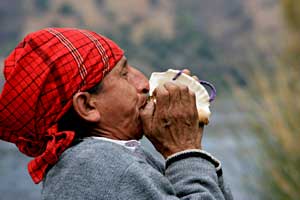The TIME of the EQUINOX
By Rigoberto Itzep Chanchabac - Daykeeper - Ajkij Maya - Kiche
“In these simple lines I express my point of view about the Equinox.”
According to our experiences of the MAYA COSMOVISION, the time of the Equinox is the time of the astral commemoration when "Jun Wukub Ajp’ IX Balam Kij" descends into the underworld after his son who has beaten the owners of the underworld. We know very well that for the world or spiritual universe, there was a big battle before the spiritual, material world could take form. It was necessary, this big fight between the light and darkness. The Equinox is a signal that reminds us of that date for eternity, that moment, when the day has become longer than the night. We know the New Year has arrived and is a day of commemoration for the Haab. We call this day Nim Luj A Wasil Kij. It is the day our Grandfathers dreamed and expect to see the hero descend into the Underworld, in a shape like a pyramid, with his head decorated with many feathers, with all the colors of the rainbow. That was the beginning of the light. Since then our ancestors have built temples in the pyramid shape and this was the beginning of the tradition of temple building. But today, almost nobody knows about this historical event.
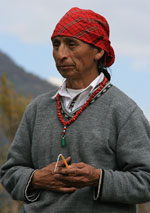
The Celebration of
WAJSHIKIB BATZ' in Momostenango
By Rigoberto Itzep Chanchabac (Daykeeper-Ajkij Maya-Kiche)
Momostenango is a Maya-Kiche village located in the Highlands of Guatemala, and have played an important role as a ceremonial center in the prehispanic Maya-Kiche group.
Since remote time they kept their own Mayan Calendar like today. One of the most important date (in the spiritual path) is the wajshikib
Batz’ Oj (8 Batz’= 8 weather or Thread, the first thread or the first day) this is the day of the initiation for the Daykeeper (Aj Kij) - The
formation of the Aj Kij (Daykeeper Priest) has been preserved for centuries in the oral tradition of the Aj Kijab (priesthood). The Wajshikib Batz’ ceremony and altars are basic to the Maya-Kiche religion, synthesizing the spirits of the universal cosmic element such air, fire, earth, water. Divinities in the Nature that make a only one divinity, when our grandfathers said “JUYUP TAKAJ” (God World). In this way the people of Momostenango keep and preserve their practices
of the sacred days of the Maya-Kiche Sacred Calender, every time when is WAJSHIKIB BATZ’, males and females, childrens and youths participate in their own shrines and rituals like they have to do it. “The Ritual New Year, Wajshikib Batz’, is when a person assumes his or her mission to be a Maya Priest (Ajkij) and is ordained."
The Mayan Ritual Calendar New Year Festival Wajshakib' B'atz
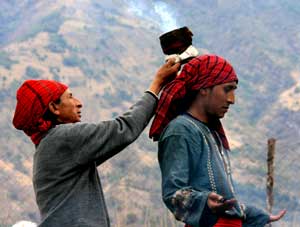 Wajshakib' B'atz (Eight Thread) is the most important holiday and festival in the K'iche Mayan ritual calendar. The 260 day ritual calendar (Tzolk'in) begins on the day Wajshakib' B'atz which means Eight Thread and is the holiest day in this cycle; it is the main date used to initiate new daykeepers. The new initiate is presented to the public for the first time on this date and given a Sacred Bundle, a hand-woven cloth bag containing red seeds and crystals called a Vara Sagrada; this Sacred Bundle symbolizes the new daykeeper's sacred mission and vocation, his or her spiritual power, ability and skill as a daykeeper/K'iche Maya spiritual guide. The red seeds in the cloth bag are used for divination readings; the apprentice daykeeper is taught an ancient system of divination based on the ritual calendar. Wajshakib' B'atz (Eight Thread) is the most important holiday and festival in the K'iche Mayan ritual calendar. The 260 day ritual calendar (Tzolk'in) begins on the day Wajshakib' B'atz which means Eight Thread and is the holiest day in this cycle; it is the main date used to initiate new daykeepers. The new initiate is presented to the public for the first time on this date and given a Sacred Bundle, a hand-woven cloth bag containing red seeds and crystals called a Vara Sagrada; this Sacred Bundle symbolizes the new daykeeper's sacred mission and vocation, his or her spiritual power, ability and skill as a daykeeper/K'iche Maya spiritual guide. The red seeds in the cloth bag are used for divination readings; the apprentice daykeeper is taught an ancient system of divination based on the ritual calendar.
The initiation on the date Wajshakib' B'atz represents a union or marriage between the daykeeper's material form and his spiritual essence, between his physical existence and his spiritual mission in life. The initiates wear flower wreaths on their heads and flower necklaces to symbolize their marriage to their sacred spiritual mission and they also dance around the sacred ceremonial fire holding their Sacred Bundle as if they were dancing with a partner or new spouse. The Sacred Bundle is considered the first wife or first husband of the new initiate, their spiritual partner or spouse who comes first in their life.
The daysign B'atz means thread and represents the umbilical cord which is said to be composed of eight threads. The date Wajshakib' B'atz/Eight Thread has the energy and vibration of the daysign B'atz, Chuen in Yucatecan, and the number eight. B'atz is the first daysign in the order of the 20 daysigns in the K'iche Mayan ritual calendar. Some commonly-held meanings of the daysign B'atz are: weaving, movement, process, development, evolution, human evolution and development, time, unity, solidarity, sense of family and community, the infinity of time, the cycles of nature, cycles of time, the weaving of history by time and through time, initiation, a new beginning, a new cycle, new life, pregnancy and human gestation. The number eight and the daysign B'atz both represent the weaving of life, the thread of life and of time which also symbolizes a human lifetime, the umbilical cord and the sacred energies of birth. Eight also represents the human being and the human chain. All numbers are sacred symbols. A couple has eight limbs and they create a new life together; the new being develops in the mother via the umbilical cord which contains eight divisions and brings the developing infant nutrients and oxygen. The 260 days of the K'iche ritual calendar represent nine moon cycles [9x29=261] which symbolize the nine months of human gestation.
Momostenango, Guatemala has been a ceremonial center for over 1,000 years and is a Mecca of Mayan spirituality. The Mayan calendar is followed more closely there than in any other traditional Mayan community. Momostenango has many outdoor public altars and shrines at which Maya daykeepers, priests and community spiritual advisors do sacred ceremony; they are not only local people, but also many from other Mayan communities and tribes. Momostenango has been a place of pilgrimage for more than a thousand years. In addition to initiating and presenting new daykeepers on the date Wajshakib' B'atz, local and visiting Maya priests also do ceremonies for five days at five main public altars in the town, praying for their families, friends, colleagues, associates and the community as a whole.
| |
Mision Maya Wajshakib Batz
[Mayan Mission 8 Thread]
is led by the eminent spiritual guide Don Rigoberto Itzep Chanchavac and his family.
[Mayan priests and day-keepers are refered to as "spiritual guides" in Guatemala] It sets forth the following objectives:
1. Develop Mayan education for the children of Mayan
spiritual guides
2. Study K'iche' Mayan Cosmovision in depth with its
rules and laws
3. Give lectures on Mayan culture
4. Promote intercultural exchanges
The Mayan school has been developing in my home
since 1997. The goal of this school is to raise the
awareness of children and youth in regard to the con-
tents of Mayan Cosmovision. Instruction consists of
Sunday classes from 9AM to 11AM beginning Feb 15th on
the Mayan Calendar date "belejeb k'anil" [9 Seed] and
ending in mid-November. Classes are held at Mision
Maya headquarters and deal with the following topics:
ancestral dances, music,ancestral medicine,
handicrafts, etc. My main concern, above all, is the environment,
ecology, the flora and fauna. I designed this program,
along with the participating children and youth, for
the purpose of generating these values and principles
in the consciousness of future generations. My
activity is well defined and thoroughly based on the principles
of Mayan culture. For this reason, with my heart in my
hand, I am asking economic support in the form of
voluntary donations.
A school is being developed in very limited space, and are looking for a large lot to
build a new school. There are a number of lots available for sale here, but the prices are beyond our
means. I need a lot large enough for the children to study dances[ancestral Mayan dances] and so I'm asking
support for this reason. At the same time, I have a plan to create a secondary school at the "educacion basica"
level [8th, 9th and 10th grade] for the children of those same spiritual guides that would make Mayan
values a priority. All the official schools in Momostenango have the goal of removing cultural values from
the consciousness of children and youth; for these very reasons we are planning to create the new school and
purchase a large lot.
Here is a list of the subjects and program content of the current school:
1. Reading and Writing the K'iche' Mayan Language
2. Mayan Calendar
3. Math, Numbers and Colors in K'iche'
4. Mayan History
5. Mayan Art
6. Spirituality, Cosmovision, Mythology
These are the subjects of the school's first four year stage of study.
This is the brief history of my activity. A thousand thanks for listening to me!
Sincerely,
Rigberto Itzep and family
(Keep in mind a lot of this information may be out of date by now)
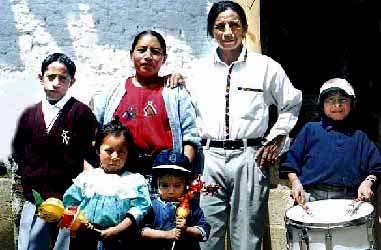
Rigoberto Itzep and his beautiful wife Maria and his children - taken in 1997
Initiation into the Mysteries of the Kiche Maya of Momostenango.
An article about an amazing experience in Momostenango with Rigoberto ~ by Aluna Joy
|
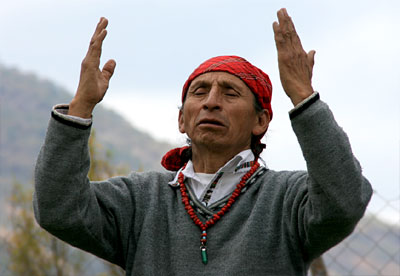
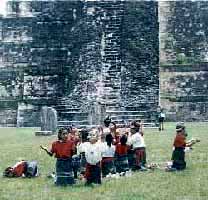
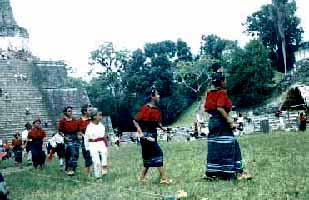
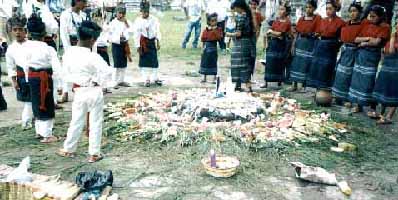
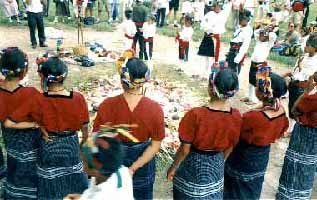
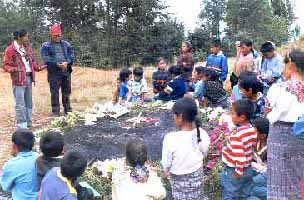
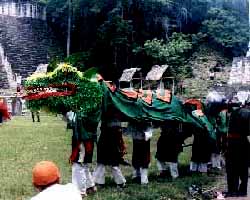
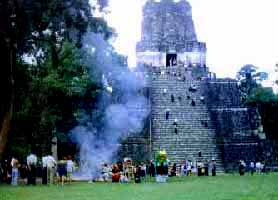
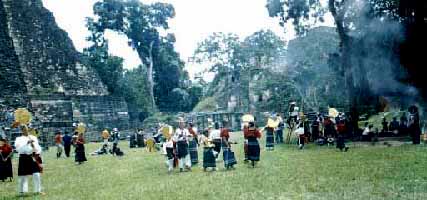
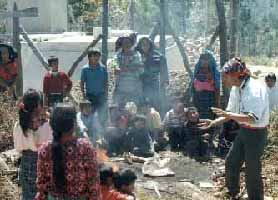
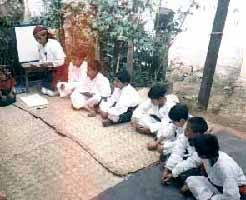

 Wajshakib' B'atz (Eight Thread) is the most important holiday and festival in the K'iche Mayan ritual calendar. The 260 day ritual calendar (Tzolk'in) begins on the day Wajshakib' B'atz which means Eight Thread and is the holiest day in this cycle; it is the main date used to initiate new daykeepers. The new initiate is presented to the public for the first time on this date and given a Sacred Bundle, a hand-woven cloth bag containing red seeds and crystals called a Vara Sagrada; this Sacred Bundle symbolizes the new daykeeper's sacred mission and vocation, his or her spiritual power, ability and skill as a daykeeper/K'iche Maya spiritual guide. The red seeds in the cloth bag are used for divination readings; the apprentice daykeeper is taught an ancient system of divination based on the ritual calendar.
Wajshakib' B'atz (Eight Thread) is the most important holiday and festival in the K'iche Mayan ritual calendar. The 260 day ritual calendar (Tzolk'in) begins on the day Wajshakib' B'atz which means Eight Thread and is the holiest day in this cycle; it is the main date used to initiate new daykeepers. The new initiate is presented to the public for the first time on this date and given a Sacred Bundle, a hand-woven cloth bag containing red seeds and crystals called a Vara Sagrada; this Sacred Bundle symbolizes the new daykeeper's sacred mission and vocation, his or her spiritual power, ability and skill as a daykeeper/K'iche Maya spiritual guide. The red seeds in the cloth bag are used for divination readings; the apprentice daykeeper is taught an ancient system of divination based on the ritual calendar. 